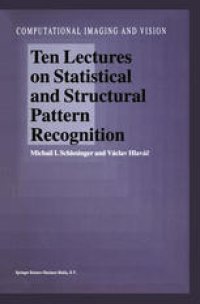
Ebook: Ten Lectures on Statistical and Structural Pattern Recognition
- Tags: Information Systems Applications (incl. Internet), Artificial Intelligence (incl. Robotics), Statistics general, Symbolic and Algebraic Manipulation
- Series: Computational Imaging and Vision 24
- Year: 2002
- Publisher: Springer Netherlands
- Edition: 1
- Language: English
- pdf
Preface to the English edition This monograph Ten Lectur,es on Statistical and Structural Pattern Recognition uncovers the close relationship between various well known pattern recognition problems that have so far been considered independent. These relationships became apparent when formal procedures addressing not only known prob lems but also their generalisations were discovered. The generalised problem formulations were analysed mathematically and unified algorithms were found. The book unifies of two main streams ill pattern recognition-the statisti cal a11d structural ones. In addition to this bridging on the uppermost level, the book mentions several other unexpected relations within statistical and structural methods. The monograph is intended for experts, for students, as well as for those who want to enter the field of pattern recognition. The theory is built up from scratch with almost no assumptions about any prior knowledge of the reader. Even when rigorous mathematical language is used we make an effort to keep the text easy to comprehend. This approach makes the book suitable for students at the beginning of their scientific career. Basic building blocks are explained in a style of an accessible intellectual exercise, thus promoting good practice in reading mathematical text. The paradoxes, beauty, and pitfalls of scientific research are shown on examples from pattern recognition. Each lecture is amended by a discussion with an inquisitive student that elucidates and deepens the explanation, providing additional pointers to computational procedures and deep rooted errors.
This monograph explores the close relationship of various well-known pattern recognition problems that have so far been considered independent. These relationships became apparent with the discovery of formal procedures for addressing known problems and their generalisations. The generalised problem formulations were analysed mathematically and unified algorithms were found. The main scientific contribution of this book is the unification of two main streams in pattern recognition - the statistical one and the structural one. The material is presented in the form of ten lectures, each of which concludes with a discussion with a student.
It provides new views and numerous original results in their field. Written in an easily accessible style, it introduces the basic building blocks of pattern recognition, demonstrates the beauty and the pitfalls of scientific research, and encourages good habits in reading mathematical text.
This monograph explores the close relationship of various well-known pattern recognition problems that have so far been considered independent. These relationships became apparent with the discovery of formal procedures for addressing known problems and their generalisations. The generalised problem formulations were analysed mathematically and unified algorithms were found. The main scientific contribution of this book is the unification of two main streams in pattern recognition - the statistical one and the structural one. The material is presented in the form of ten lectures, each of which concludes with a discussion with a student.
It provides new views and numerous original results in their field. Written in an easily accessible style, it introduces the basic building blocks of pattern recognition, demonstrates the beauty and the pitfalls of scientific research, and encourages good habits in reading mathematical text.
Content:
Front Matter....Pages i-xix
Bayesian statistical decision making....Pages 1-23
Non-Bayesian statistical decision making....Pages 25-71
Two statistical models of the recognised object....Pages 73-99
Learning in pattern recognition....Pages 101-136
Linear discriminant function....Pages 137-214
Unsupervised learning....Pages 215-274
Mutual relationship of statistical and structural recognition....Pages 275-305
Recognition of Markovian sequences....Pages 307-395
Regular languages and corresponding pattern recognition tasks....Pages 397-477
Context-free languages, their two-dimensional generalisation, related tasks....Pages 479-505
Back Matter....Pages 507-522
This monograph explores the close relationship of various well-known pattern recognition problems that have so far been considered independent. These relationships became apparent with the discovery of formal procedures for addressing known problems and their generalisations. The generalised problem formulations were analysed mathematically and unified algorithms were found. The main scientific contribution of this book is the unification of two main streams in pattern recognition - the statistical one and the structural one. The material is presented in the form of ten lectures, each of which concludes with a discussion with a student.
It provides new views and numerous original results in their field. Written in an easily accessible style, it introduces the basic building blocks of pattern recognition, demonstrates the beauty and the pitfalls of scientific research, and encourages good habits in reading mathematical text.
Content:
Front Matter....Pages i-xix
Bayesian statistical decision making....Pages 1-23
Non-Bayesian statistical decision making....Pages 25-71
Two statistical models of the recognised object....Pages 73-99
Learning in pattern recognition....Pages 101-136
Linear discriminant function....Pages 137-214
Unsupervised learning....Pages 215-274
Mutual relationship of statistical and structural recognition....Pages 275-305
Recognition of Markovian sequences....Pages 307-395
Regular languages and corresponding pattern recognition tasks....Pages 397-477
Context-free languages, their two-dimensional generalisation, related tasks....Pages 479-505
Back Matter....Pages 507-522
....